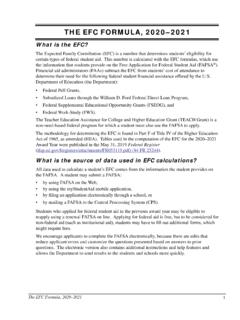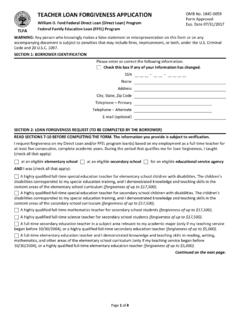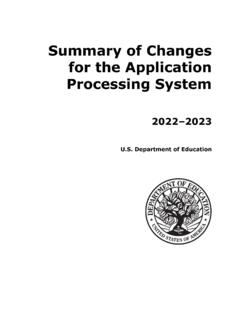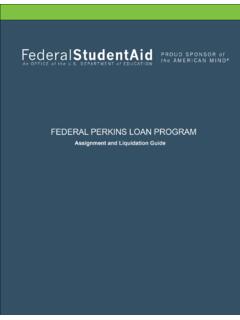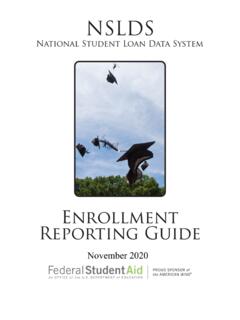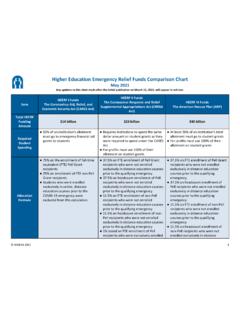Transcription of THE EFC FORMULA, 2021–2022 - ed
1 The efc formula , 2021 2022 1 THE efc formula , 2021 2022 What is the EFC?The expected family Contribution (EFC) is a number that determines students eligibility for certain types of federal student aid. This number is calculated with the EFC formulas, which use the information that students provide on the Free Application for Federal Student Aid (FAFSA ). Financial aid administrators (FAAs) subtract the EFC from students cost of attendance to determine their need for the following federal student financial assistance offered by the Department of Education (the Department): Federal Pell Grants, Subsidized Loans through the William D. Ford Federal Direct Loan Program, Federal Supplemental Educational Opportunity Grants (FSEOG), and Federal Work-Study (FWS).
2 The Teacher Education Assistance for College and Higher Education Grant (TEACH Grant) is a non-need-based federal program for which a student must also use the FAFSA to apply. The methodology for determining the EFC is found in Part F of Title IV of the Higher Education Act of 1965, as amended (HEA). Tables used in the computation of the EFC for the 2021 2022 Award Year were published in the June 5, 2020 Federal Register ( ) (85 FR 34605).What is the source of data used in EFC calculations?All data used to calculate a student s EFC comes from the information the student provides on the FAFSA. A student may submit a FAFSA: by using FAFSA on the Web, by using the myStudentAid mobile application, by filing an application electronically through a school, or by mailing a FAFSA to the Central Processing System (CPS).
3 Students who applied for federal student aid in the previous award year may be eligible to reapply using a renewal FAFSA online. Applying for federal aid is free, but to be considered for non-federal aid (such as institutional aid), students may have to fill out additional forms, which might require encourage applicants to complete the FAFSA electronically, because there are edits that reduce applicant errors and customize the questions presented based on answers to prior questions. The electronic version also contains additional instructions and help features and allows the Department to send results to the students and schools more The efc formula , 2021 2022 Who processes the FAFSA, and how are students notified of their EFC?The CPS receives the student s FAFSA data, either electronically or on the paper application, and uses it to calculate an EFC.
4 After the FAFSA has been processed, the CPS sends the student an output document containing information about his or her application results. This document, which can be paper or electronic, is called a Student Aid Report (SAR). The SAR lists all the information from the application and indicates whether the application was complete and signed. If the application is complete and signed and there are no data conflicts, the SAR also includes the student s EFC. Students are instructed to carefully check the accuracy of the information on the SAR. All schools listed on the student s FAFSA receive application information and processing results in an electronic file called an Institutional Student Information Record (ISIR).Which efc formula Worksheet should be used?There are three regular formulas and a simplified version of each: formula A, for dependent students; formula B, for independent students without dependents other than a spouse; and formula C, for independent students with dependents other than a simplified versions of the efc formula worksheets do not use assets in the calculation.
5 See pages 4 and 5 for information on which students qualify for the simplified formulas. Instructions for determining which applicants are eligible for the automatic zero EFC calculation are included in each worksheet. See page 5 for more information on which students qualify for an automatic zero A Worksheet ..pages 9 12 Simplified formula A Worksheet ..pages 13 16 formula B Worksheet ..pages 17 18 Simplified formula B Worksheet ..pages 19 20 formula C Worksheet ..pages 21 22 Simplified formula C Worksheet ..pages 23 24 Tables ..pages 25 29 Note: Do not complete the shaded areas in the simplified worksheets; asset information is not required in the simplified efc formula , 2021 2022 3 What is the definition of an independent student?Because the efc formula for a dependent student uses parental data and the two formulas for independent students do not, the first step in calculating a student s EFC is to determine his or her dependency status.
6 For the 2021 2022 Award Year, a student is automatically determined to be independent for federal student aid purposes if he or she meets one or more of the following criteria: The student was born before January 1, 1998. The student is married or separated (but not divorced) as of the date of the application. At the beginning of the 2021 2022 school year, the student will be enrolled in a master s ordoctoral degree program (such as MA, MBA, MD, JD, PhD, EdD, or graduate certificate,etc.). The student is currently serving on active duty in the Armed Forces or is a NationalGuard or Reserves enlistee called into federal active duty for purposes other than training. The student is a veteran of the Armed Forces (see the definition in the box on page 4). The student has or will have one or more children who receive more than half of their supportfrom him or her between July 1, 2021, and June 30, 2022.
7 The student has dependent(s) (other than children or spouse) who live with him or her andwho receive more than half of their support from the student, now and through June 30, 2022. At any time since the student turned age 13, both of the student s parents were deceased, orthe student was in foster care or was a dependent or ward of the court. As determined by a court in the student s state of legal residence, the student is now, or wasupon reaching the age of majority, an emancipated minor (that is, released from control byhis or her parent or guardian). As determined by a court in the student s state of legal residence, the student is now, or wasupon reaching the age of majority, in legal guardianship. On or after July 1, 2020, the student was determined by a high school or school districthomeless liaison to be an unaccompanied youth who was homeless or was self-supportingand at risk of being homeless.
8 On or after July 1, 2020, the student was determined by the director of an emergency shelteror transitional housing program funded by the Department of Housing and UrbanDevelopment to be an unaccompanied youth who was homeless or was self-supporting and atrisk of being homeless. At any time on or after July 1, 2020, the student was determined by a director of a runawayor homeless youth basic center or transitional living program to be an unaccompanied youthwho was homeless or was self-supporting and at risk of being homeless. The student is determined by the college financial aid administrator to be an unaccompaniedyouth who is homeless or is self-supporting and at risk of being students who do not meet any of the above criteria but who have documented unusual circumstances, an FAA can override their dependency status from dependent to independent.
9 For information about dependency overrides, see the Application and Verification Guide, which is part of the Federal Student Aid Handbook and can be found on the IFAP Web site. 4 The efc formula , 2021 2022 TERMS USED IN THE DEFINITION OF AN INDEPENDENT STUDENTLEGAL DEPENDENT. Any children of the student who receive more than half of their support from the student (children do not have to live with the student), including a biological or adopted child. Also, any persons, other than a spouse, who live with the student and receive more than half of their support from the student now and will continue to receive more than half of their support from the student through June 30, A student who: (1) has engaged in active service in the Armed Forces (Army, Navy, Air Force, Marines, or Coast Guard), or has been a member of the National Guard or Reserves who was called to active duty for purposes other than training, or was a cadet or midshipman at one of the service academies, or attended a military academy preparatory school, and (2) was released under a condition other than dishonorable.
10 A veteran is also a student who does not meet this definition now but will by June 30, students qualify for the simplified EFC formulas?The following criteria determine which students have their EFCs calculated by a simplified formula . Assets are not considered in the simplified EFC the 2021 2022 Award Year, a dependent student qualifies for the simplified efc formula if both (1), below, and (2), on the next page, are true:(1) Anyone included in the parents household size (as defined on the FAFSA) received benefits during 2019 or 2020 from any of the designated means-tested federal benefit programs: the Medicaid Program, the Supplemental Security Income (SSI) Program, the Supplemental Nutrition Assistance Program (SNAP), the Free and Reduced Price School Lunch Program, the Temporary Assistance for Needy Families (TANF) Program1, and the Special Supplemental Nutrition Program for Women, Infants, and Children (WIC).
